|
Red Wing Stoneware
By Dan DePasquale & Larry Peterson
Posted 5/2010
|
 |
Through the history of the pottery industry in Red Wing, Minnesota, one can trace how this industry developed and changed over the course of almost 100 years. The Red Wing Potteries was one of the few in the United States that developed when salt-glazed ware was produced; it transitioned into white ware and art ware, and it finally ended during the dinnerware production era.
|
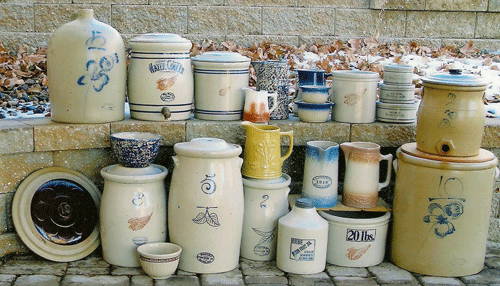
|
|
An astounding array of products were produced by the
Red Wing Stoneware Companies.
|
As the needs of the people changed over the span of a century, the Red Wing Potteries adapted to those changes and introduced many new lines of products. The fun of collecting Red Wing is that there really is something for almost any type of collector who likes pottery. If you like dinnerware, it is easy to find a dinner ware pattern to match your taste, as Red Wing produced more than 50 different patterns with names such as Delta Blue, Flight, Midnight Rose, Pepe, Plum Blossom and Tampico. While prices on dinnerware typically range from $10 to $50, some specialty pieces have brought more than $500.
If your collecting interest is art ware, it is easy to see how Red Wing can satisfy your appetite. Red Wing produced a large number of pieces that included vases, lamps, statuettes, planters and console sets with Art Deco and Art Nouveau shapes introduced by George Rumrill, between 1932 and 1937. Fascinating glazes were incorporated into many designs. If you are a cookie jar collector, you most likely have a number of Red Wing jars in your collection. More than 25 different styles were made with a multitude of glazes to make a fascinating array of options for any collector to choose from.
In the area of stoneware, and the main focus of this article, the variety of items manufactured was second to none. The products were produced by three main stoneware companies of Red Wing. Those companies were the Red Wing Stoneware Company, the Minnesota Stoneware Company and the North Star Stoneware Company. Eventually, these companies merged into one. Below is a brief timeline of the existence of these companies.
| A
brief
time
line
of these
companies.
Red Wing Stoneware Company: 1877-1906
Minnesota Stoneware Company: 1883-1906
North Star Stoneware Company: 1892-1896
Union Stoneware Company (the above three companies formed a selling consortium):
1894-1906
Red Wing Union (North Star closed; Red Wing and Minnesota joined as one):
1906-1936
Red Wing Potteries (changed name to better reflect the product line): 1936-1967
|
Stoneware collecting, whether eastern, southern or mid-western, has been increasing for many years. Early salt-glaze ware offers beauty, unique designs, and a chance to acquire genuine Americana. The many products produced by Red Wing have been a key reason why collecting Red Wing Stoneware has sky-rocketed. Of course, with the popularity increasing so has the price for selected pieces.
The high caliber of clay in the Red Wing area meant the wares produced were of excellent quality and highly sought after. Initial items produced were water coolers, butter churns, bowls (called milk pans), crocks (called jars), jugs and flower pots. Following is a description of several of types of Red Wing ware.
Water coolers. Coolers were a production staple throughout the history of stoneware production. The early catalogs referred to the coolers as “Water Jars” which came in seven sizes: 2, 3, 4, 5, 6, 8 and 10 gallons. The total number of salt glaze water coolers that survive today is small, thus commanding high prices. The earliest salt glaze coolers usually had the gallon number, a slip-cup design, and what is called a “bung hole” for the spigot to go into. When white ware became available, “Ice Water” was stenciled on the cooler and then later was changed to “Water Cooler.” “Ice Water” and early “Water Cooler” stamps were very ornate with scrolling around the words while later production pieces were very plain, simply having the words “Water Cooler.” The two-gallon size is difficult to find.
Churns. The Red Wing catalogs indicated that churns were made in six sizes: 2, 3, 4, 5, 6 and 8 gallons. The most common sizes are 3 to 6 gallon. The two-gallon salt-glaze churn is very rare, and we have seen 10-gallon salt glaze churns, even though they did not appear in the early catalogs. Later churns with the Red Wing logo added the 8 and 10 gallon sizes, but these are rare also. Churns have a unique and delicate shape, thus making them attractive and very collectible.
Crocks. With thousands and thousands of crocks produced over the history of the stoneware companies, it is no wonder, regardless of taste, people can find decorated crocks that appeal to them. The varieties seem endless and are a collector’s dream. Some people specialize in one kind of decoration, such as stamped birch leaves, while others want crocks stamped with the Red Wing logo. Some only collect salt glaze leaves, or butterflies or geometric shapes. This truly is an enjoyable area for collecting because of the variety of crocks available.
Kitchen stoneware. Kitchenware has always been highly collectible in general, and within this area, pitchers seem to be sought after by both Red Wing and non-Red Wing collectors. While pitchers were functional in nature with a specific purpose, their basic form is attractive. Pitchers appeal to a large number of people because they represent a wide variety of shapes, styles and colors. Red Wing made blue/white, blue and brown sponge, white, brown and other colored pitchers. Additional kitchen items produced were bowls, pantry jars, pie plates, refrigerator jars and bean pots. Even sets of kitchenware were made. Gray Line, commonly called sponge band, is an example. In this set, one can find bowls, beater jars, cake plates, batter bowls, stacking refrigerator jars with lids, reamers, mugs and cookie jars, to name a few.
Advertising ware. Starting around 1900, stoneware with advertising on it appeared on a large scale. Merchants eager to keep their name in front of customers ordered stoneware with their business name stamped on the pieces. Advertising pieces from Texas to Canada and from New York to Washington State can be found. You might even find a piece with your name on it! Many people collect pieces from either their state or home town. This is a fun area to collect because of the variety and unique sayings that one can find.
Here
is an
example
of advertising
found
on selected
pieces:
| 1.
|
“USE YOUR BEAN Shop at the Fair Store” – on a bean pot.
|
| 2.
|
“P. Z. the Shoe Man” – on blue/white pitchers and beater jars.
|
| 3.
|
“Where Prices are Lowest and Quality the Highest” – on a blue/white pitcher.
|
| 4.
|
“Make Our Store Your Headquarters” – on a churn.
|
| 5.
|
“When Beating think of Eating Good Groceries and Meat” – on a beater jar.
|
| 6.
|
“Buy Your General Merchandise Jewelry, Hardware and Farm Machinery At A. H. Harms 3 Big Stores” – on a crock and beehive jug.
|
| 7.
|
“Do Your Trading Where I Came From” – on a canning jar called a “stone mason” (which competed with the new glass mason canning jars) and on a jug.
|
|
An added benefit to collecting Red Wing is the numerous resources that exist to help you learn about and see the many items available and to get an idea about relative value. The Red Wing Collectors Society and the Red Wing Foundation provide a wealth of knowledge and assistance to new collectors. The Red Wing Collector’s Society consists of a large group of collectors, and it has a national convention every year in Red Wing, Minn., that includes an education day, auction and show and sale. Membership is very reasonable, and a newsletter and option to purchase a commemorative are offered. The Society’s website is redwingcollectors.com.
-------------------------------
Dan DePasquale and Larry Peterson are long-time Red Wing collectors and charter members of the Red Wing Collector’s Society. Dan recently retired as associate superintendent of the Norfolk, Nebraska Public Schools and Larry just retired as regional manager with Edina Realty in Minneapolis. A full color book, Red Wing Encyclopedia, by DePasquale and Peterson was just released.
|
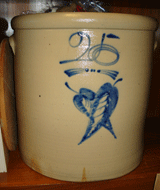
25-gallon salt-glazed crock with massive leaves. Impressed on the back is “Red Wing Stoneware Company.”
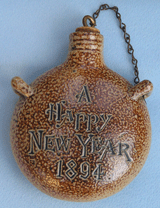
Salt-glazed canteen measuring 3.5 inches tall and 2.75 inches wide.
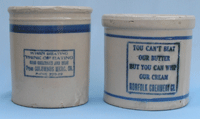
Two different styles of advertising beater jars. On right: “You can’t beat our butter, but you can whip our cream. Norfolk Creamery Co.” On left: “When beating think of eating. Good Groceries and Meat From Columbus Merc. Co. Phone 229-29.” Note the taller jar has a “tie-ring” at the top.
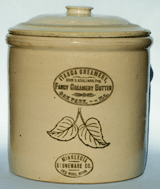
“Elephant Ear” leaf design with advertising and Minnesota Stoneware Co. oval.
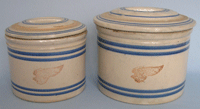
Three-pound and five-pound pantry jars with original lids. The set contains eight different sizes.
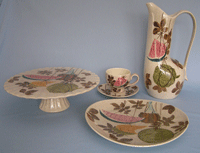
Tampico dinnerware is a
festive pattern.
|